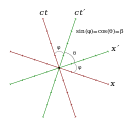[
WARNING: This take of mine is wrong and rather reflects my own initial misunderstanding of Einsteinian relativity. Indeed, try and do the calculations! I am leaving it here as it might reflect some common mistakes made when seeing Einsteinian relativity for the first time. I might make it into a proper introductory article at some point.
]
[
ADDED: Meanwhile, a correct (AFAICT) first approach is here:
Special Relativity: Inertial Frames
Corollary 1: Retrocausation...
Corollary 2: Nobody understands Relativity...
]
In the context of special relativity, we present a twins experiment that is symmetric between the twins, so that a paradox appears inescapable, in the form of a violation of the principle of causality.
Here is the experiment (we would argue that effects of acceleration can be made arbitrarily small in our setup):
== The twins, call them L and R, are each given a clock at birth and get the clock fixed to their body: the two clocks have been previously synchronised. Assume, for simplicity, that the common origin of space-time for the clocks is set to the moment and place of the twins' birth, as well as a common choice of coordinates is made, such that the twins, at that very moment, share the same frame of reference (up to arbitrary precision).
Just after birth, the twins (with their clocks) are each embarked on a rocket. Assume collinear motion for simplicity. The two rockets start in opposite direction relative to the origin, carrying L and R respectively. The plan is for the rockets to fly away from each other at some fixed (appropriately high) constant speed for some fixed (appropriately long) proper time, then simply invert course and fly back at opposite speed to the point of origin (in space), and stop there. (Effects of acceleration can be minimised by making the total proper time the rockets are subject to acceleration appropriately small relative to the total proper time of the journey.)
The twins at that point rejoin, again sharing a common frame of reference (up to arbitrary precision). We ask what the two clocks measure for each twin in this common frame. ==
To compute results, we apply special relativity. (We advise readers go through this little but essential exercise by themselves.) We find that R's clock looks late (i.e. back in time) to L, but, *at the same time* (twins and clocks are in a common frame of reference), L's clock looks late to R! This conclusion is an inescapable consequence of the theory, and now the problem becomes how to make sense of these results. In fact, since all clocks are affected, including the biological ones, at the end of the journey each twin effectively finds the other younger than himself: then, per *reciprocity* (causality), i.e. that in the same frame of reference, if I am older than you, you must be younger than me, we can argue that each twin is at the same time younger and older than the other, which is indeed absurd!
Note that the absurdity would not be so patent if we just let the two clocks travel, hence we sent the twins, too: not because the presence of the twins is necessary for relativistic effects to occur, the clocks must be late relative to each other regardless of anyone observing them, rather because only the twins can "testify" that the conclusion of the experiment, so special relativity theory, is indeed at odds with the principle of *causality*.
Bottom line: if special relativity is correct, it must be incomplete.
